All you need to know about your products!

| 3DNews Vendor Reference English Resource - All you need to know about your products! |
||||||
 |
||||||
|
|
||||||
Choosing among HD2600XT with DDR3, DDR4, or 8600GT? Or 7900GS, X1950Pro? Tests in the No AA/AF modeAuthor:Date: 08/08/2007 Recently, we introduced Sapphire HD2600 Pro and found out how it works in terms of performance when tuned to high quality settings with the full-screen antialiasing enabled. Needless to say, such a heavy load produces a dramatic effect upon the performance of middle-end video cards equipped with a 128-bit wide memory bus. We can expect that in "lighter" modes where the requirements to video memory bandwidth are not so critical the results for HD2600XT and 8600GT may prove much better. Moreover, we'll be comparing performance of the above mentioned video cards versus representatives of the previous generation (X1950Pro ? 7900GS) which are currently occupying the same price niche but offer a 256-bit wide memory bus. According to the findings in 256-bit memory bus in middle-end video cards: is it really necessary? Theory and practice, in the modes without full-screen antialiasing video cards of 128-bit memory bus width demonstrate quite a minor lag behind their 256-bit analogs. Today, we'll find out of this assertion holds true for middle-end video cards of different generations. And of course we'll try to find out the difference in performance for two versions of Radeon HD2600XT equipped with GDDR3 and GDDR4 memory. By tradition, we'll be examining the exterior and features of the video cards which took part in the tests and then move on to the benchmarking part. AMD Radeon HD2600XT GDDR4As the name suggests, we have a specimen of the reference AMD Radeon HD2600XT video card equipped with GDDR4 memory. The video card is of quite impressive size and is equipped with quite a formidable cooler of "proprietary" red color. The video card is equipped with two DVI/Dual-Link outputs, one HDTV/S-Video-out, and occupies one standard PCI slot. There was no package for the given specimen (which is understandable), but the card comes bundled with a DVI/HDMI adapter. This adapter is quite useful. Using it, we can directly connect any device equipped with a HDMI port "digitally' to the computer, provided there is a DVI output on the video card. Therefore, we can avoid an excessive pair of digital-analog/analog-digital conversions and essentially improve the quality of the resultant picture. That is especially topical for high-resolution panels (for example, with support for HDTV). Of course, video cards not belonging to the AMD Radeon HD2xxx series will not be able transmitting the audio part together with the image to the receiving multimedia device, but that is not so critical since digital home cinemas use standalone speakers or surround systems. Under the cooler, there is a video processor and four video memory chips. The video card's power supply subsystem has been made with all solemnity, despite the relatively low power consumption of the RV630XT chip manufactured following the 65 nm process technology. There is also space for a Rage Theatre video capture chip, although the chip itself is not unsoldered. On the reverse side, there is space for additional video memory chips, so the emergence of HD2600XT versions with doubled video memory capacity is at hand. The cooler is built following the traditional scheme - an aluminum foot which cools the memory chips and power components of the power supply system via thermal spacers, with a copper core in the center and fins soldered onto to cool the GPU directly. The turbine is of modest size, but it does its job quite well and runs almost noiselessly.  As you can see, in the 2D mode the GPU temperature is at about 60°, and in the 3D mode under load the temperature of the video processor stays at about 70° C. 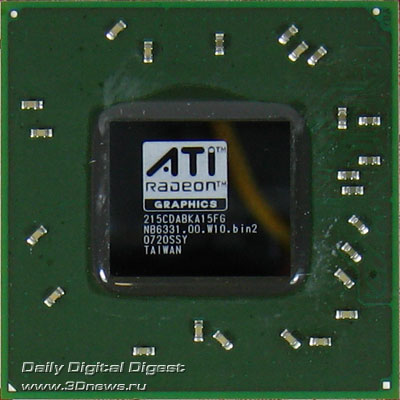 As was expected, the video processor on the reference specimen runs at the recommended 800 MHz. 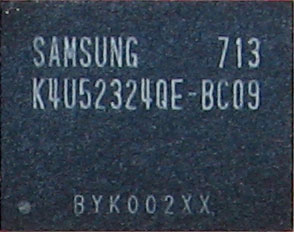 The overall capacity of the onboard video memory is 256 MB. Used are Samsung GDDR4 chips of 512 Mbit density and 0.9 ns access time, which is equivalent to the nominal frequency 1100 MHz (2200 MHz DDR). This is the nominal frequency the video memory runs. MSI HD2600XT 512 Mb GDDR3 Heat Pipe CoolingThe next video card which took part in our tests, albeit based on the same RV630XT video processor, offers a number of essential differences from the previously reviewed reference video card. Of course, the difference is not about the nice-looking package box of the MSI product. What matters more is what is shown on it. Above all, it is the capacity and type of the video memory – 512 MB GDDR3. And of course there is a passive cooling system based on heat pipes. The reverse side of the package contains a standard description of technologies supported by the video processor and the system requirements. It says the power of the PSU should be at least 450 W which provides 30 A current over the 12V line. These requirements look somehow overstated for a middle-end video card not equipped with a connector for additional power supply (which means the power consumption does not exceed 75 W - the maximum for the PCI-Express bus). We note the presence of a DVI/HDMI adapter in the bundle to plug in high-resolution panels. The package bundle in full looks like this:
As you see, the HD2600XT version equipped with GDDR3 video memory is made using a shorter PCB. The central part where there is the video processor is closed with an aluminum lid, with the heat pipes running to the reverse side of the PCB where a passive cooler is located. The front view of the PCB with the cooler removed does not change much. Under the lid, there are two more video memory chips, and that's all. There is no space for a video capture chip, but that is not a substantial shortcoming. Much of the reverse side of the PCB is hidden under the radiator made of thin aluminum fins pierced with three heat pipes. If we remove the cooler, we can find four more video memory chips under it. That's about all of the sightseeing. Despite the bulk of the structure, it does not stand out with great mass. The square frame holds the heat exchanger adjoining the GPU, with a decorative lid with the company's logo imparting completeness to the video card in general. The only point which may hinder using the MSI HD2600XT Heat Pipe Cooling in your computer is the nonstandard layout of the radiator. If the PCI-Express slot to which a video card is inserted as well as the RAM slots on the motherboard are too close to one another, and you are using RAM modules with projecting radiators, the radiator of the video card may rest against them and hinder installation into the slot. To some extent that also relates to the overly "wired" radiators of the motherboard's north bridge. In fact, the "fitting" of MSI HD2600XT Heat Pipe Cooling to motherboards at our disposal today has shown that it is more likely an exception rather than a rule. The seemingly simple and unpretentious cooler stands out for its superb cooling efficiency.  At "rest", the GPU temperature is 55°, which is even lower than in the reference AMD HD2600XT where the contribution to additional heating of the GPU is probably made by the video memory because it is in contact with the GPU radiator. In the 3D mode, the GPU temperature on MSI HD2600XT appears to be somehow higher than that on the "reference", which is natural because that is a passive cooling system. Anyway, the 5° excess can hardly be regarded as critical. That is a superb result for the passive cooling system! 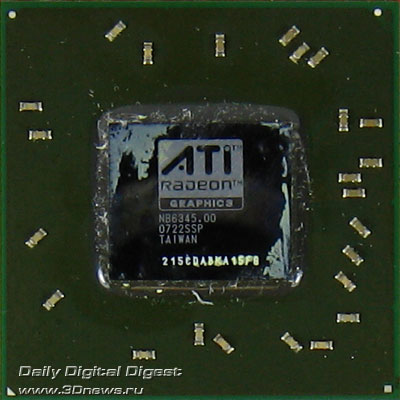 There are some differences in the mutual layout of the marking labels on the GPU chip, but be assured that it is an absolutely standard RV630XT chip running at 800 MHz, as it should be. 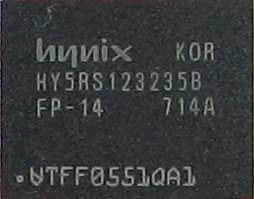 As was stated above, MSI HD2600XT Heat Pipe Cooling is equipped with 512 MB video memory capacity. Used are eight GDDR3 chips made by Hynix of 1.4 ns access time, which is equivalent to the nominal frequency 1400 MHz DDR. This is the nominal frequency the video memory runs. Point of View 8600GTWe are now introducing a typical representative of the 8600GT family which is anyway remarkable in itself. The major "spice" of this 8600GT video card made by Point of View, as you can see, is the "Ratatui" game in the bundle (with a charming infant rat starring). Perhaps the hero won the hearts of the company's designers so much that they gave the front side of the box for the image. Among the video card's advantages we note support for the HDCP. It will be of use to you if you intend to watch licensed High Definition films. The reverse side of the box presents a typical description of all the GPU features of 8600GT, in multiple languages. And even here as well, there is space for setting it in the style of "Ratatui" and the fatty little friend of the main hero. Apart from the "Ratatui" game CD, there are also:
Point of View 8600GT is equipped with two DVI ports and an analog S-Video/HDTV-out. The card takes up two standard PCI slots because of the massive radiator. On the reverse side of the PCB, there are neither additional video memory chips, nor space for them. The fastening of the cooler is very similar to what we saw on Palit products, but coolers and fasteners like these can be manufactured by whoever. The wiring of the PCB is not similar to what we saw from other manufacturers, although there are common features of course. On the GPU substrate, there are quite rigid spacers which protect the chip against cleavage, which is topical with such a massive cooler. The cooler itself is nothing special in anything - a spacious aluminum radiator, plus a very quiet fan. Due to the formidable size and therefore the larger fins area, even low RPM of the impeller is sufficient for good cooling of the video processor.  The GPU temperature at rest exceeds 50°, and in the 3D mode under load it stays at about 62°. This is the best result among the video cards which took part in our test.  The marking is somehow faded, but that is a regular G84-300 of revision A2 running at the recommended 540 MHz.  The overall capacity of the video memory on Point of View 8600GT is 256 MB assembled of 4 GDDR3 memory chips made by Qimonda (former Hynix). The access time is 1.4 ns, which is equivalent to the nominal frequency 1400 MHz DDR. The video memory runs just at this frequency. As you see, the specifications of Point of View 8600GT fully meet the recommended values. At that, we'd better stop with the exterior of participants and move on to the tests. This time, we did not run overclock the video cards but tested them in the nominal modes. Search for stable frequencies in overclocking takes up quite a time and does not guarantee reproduction of results with another video card like that. It is possible to overclock noiseless products, but we are against this approach because you'd have to add coolers, and the system appears to be either clumsy or noisy. Nevertheless, we ask the overclocking fanciers not to worry - we'll certainly come back to the topic again.
We ran the tests using the ForceWare 162.18 and Catalyst 7.7 drivers. We are currently reviewing middle-end products offering 128-bit wide memory bus, therefore we'll be testing the cards in quality modes but without full-screen antialiasing and anisotropic filtering enabled. Apart from the above three video cards HD2600XT GDDR3/4 and 8600GT, the diagrams show the results for previous-generation representatives – X1950Pro and 7900GS (at recommended frequencies). Why did we take just these? Because by their price they are very close to the middle-end novelties, but offer a 256-bit wide memory bus albeit lack support for DX10. Nowadays, while there are no games supporting DirectX 10, it is hard to decide what should be given preference to – proven "oldies" with a wide memory bus which are able demonstrating quite a good-quality picture even in the AA/AF mode, or to ambitious "new kids" which support DirectX 10 although offering a merely 128-bit memory bus. According to the findings in 256-bit memory bus in middle-end video cards: is it really necessary? Theory and practice, in the No AA/AF mode the difference should not be really significant. We'll now verify that. We'll also find out how the performance of HD2600XT differs depending on the use of GDDR3 and GDDR4 video memory. 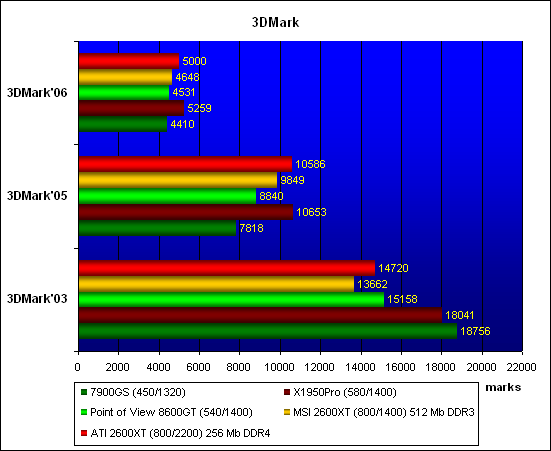 At 3DMark’05/06, the new video cards by AMD feel fine. Radeon X1950Pro takes a lead, with HD2600XT GDDR4 running almost on par, and HD2600XT with GDDR3 is lagging a bit behind it. At these tests, 8600GT takes a lead over the "oldie" 7900GS, but in the old 3DMark’03 we see a reverse picture. The cards with 256-bit wide memory bus leave all the others well behind.  At Oblivion, superiority is demonstrated by new AMD cards, with the "oldies" X1950Pro and 7900GS lagging far well behind. However, as the resolution goes up the gap in results drops substantially.  This time as well, Radeon cards - traditional leaders at Need for Speed Carbon - have remained unshakeable. On the other hand, X1950Pro and not HD2600XT leaves the others well behind.  At Serious Sam II, where NVIDIA's video cards have traditionally been favorites, X1950Pro again rushes forward. Nevertheless, the results for HD2600XT and 8600GT have ranked in way as it should be.  Programmers at AMD have done a good job optimizing the OpenGL drivers for their video cards, so at Quake 4,NVIDIA's traditional "estate", HD2600XT GDDR4 is a bit faster than 8600GT, but the absolute leadership belongs to 7900GS, which is no wonder.  At Prey, built in the same engine as Quake 4, HD2600XT GDDR4 suddenly takes a lead, although with the rise of resolution it anyway gives in its leading positions, but to whom? Again - to Radeon X1950Pro.  At F.E.A.R., X1950Pro again proves to be an irrefutable leader, and both the HD2600XT cards lose to 8600GT - even the bandwidth of GDDR4 does not help.  At Call of Juarez, the picture is antipodal. NVIDIA's representatives prove to be outsiders, whereas HD2600XT GDDR4 competes quite successfully versus the leader – X1950Pro. HD2600XT GDDR3 versus GDDR4The results of tests have shown that between the HD2600XT versions with GDDR3 and GDDR4 memory there is no substantial difference in performance. Let's look deeper and find the differences at a more detailed level. To this end, we'll be using the methodology described here. That is, with the GPU speed fixed (it is the same in both HD2600XT versions), we'll be changing the video memory frequency. We'll produce two lines of results, as is shown on the below graph.  As the test application, we took Quake 4 as before. The tests were run at 1280?1024 in the No AA/AF mode. The bullet points on the graph depict the states corresponding to the video memory frequencies recommended for these cards. As you see, the HD2600XT version equipped with GDDR4 video memory proves to be faster, but what happens if we overclock the video memory to values above the nominal? Look - the angle of inclination of the tangent to the lilac line (GDDR3 memory) at a point corresponding to the nominal frequency is higher than the angle of inclination of the similar tangent for the blue line (GDDR4 memory). That means overclocking of the video memory on HD2600XT will be more effective in terms of rise results. You can make preliminary findings by the graph, but their correlation to the real state of affairs will become known once we test the video cards in overclocking. Lastly, we can see from the same graph how the timings of video memory affect the performance of the card in general. To this end, it suffices to compare the results corresponding to the same video memory frequency. In these conditions, the results for HD2600XT with GDDR3 appear to be higher, which is caused just by the more aggressive timings of the video memory as compared to GGDR4. Final WordsAgain, we have produced quite expectable results. Despite their age, the "oldies" X1950Pro and 7900GS are demonstrating a good performance. However, in the modes without full-screen antialiasing the middle-end novelties offering 128-bit wide memory bus are quite capable of competing on par, and in some exceptional case even surpass them. Today's owners of X1950Pro and 7900GS hardly win from migration to video cards of the HD2600XT and 8600GT class. On the other hand, those who have long intended to upgrade their video systems may choose a middle-end video card to their taste, which would be comparable at performance and support for DirectX 10. As regards comparison of HD2600XT versions, they have proved very close at performance. Detailed investigation allows to assume that in applications critical to the video memory bandwidth, and a minor advantage will be with HD2600XT with GDDR4 memory. If the application is primarily sensitive to the video memory timings, then the version with GDDR3 memory will prove faster to a higher probability. |
|
|||||